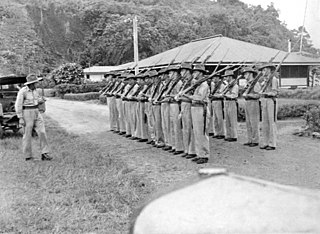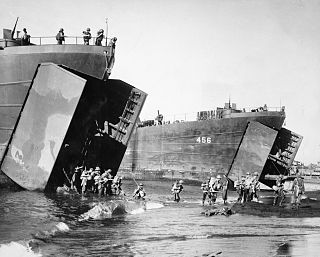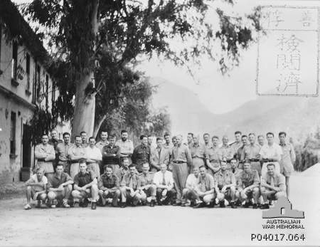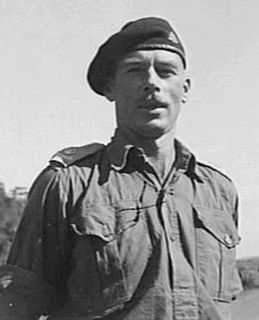
The 6th Division was an infantry division of the Australian Army. It was raised briefly in 1917 during World War I, but was broken up to provide reinforcements before seeing action. It was not re-raised until the outbreak of World War II, when it was formed as a unit of the Second Australian Imperial Force. Throughout 1940–41 it served in the North African Campaign, the Greek campaign, on Crete and in Syria, fighting against the Germans, Italians and Vichy French. In 1942, the division left the Middle East and returned to Australia to meet the threat of Japan's entry into the war. Part of the division garrisoned Ceylon for a short period of time, before the division was committed to the New Guinea campaign. In New Guinea, its component brigades had a major role in the successful counter-offensive along the Kokoda Track, at Buna–Gona and around Salamaua–Lae in 1942–43. Throughout late 1943–44, the division was re-organised in Australia before being committed as a complete formation to one of the last Australian operations of the war around Aitape–Wewak in 1944–45.

The New Guinea campaign of the Pacific War lasted from January 1942 until the end of the war in August 1945. During the initial phase in early 1942, the Empire of Japan invaded the Australian-administered Mandated Territory of New Guinea and the Australian Territory of Papua and overran western New Guinea, which was a part of the Netherlands East Indies. During the second phase, lasting from late 1942 until the Japanese surrender, the Allies—consisting primarily of Australian forces—cleared the Japanese first from Papua, then the Mandate and finally from the Dutch colony.

The Battle of Wau, 29 January – 4 February 1943, was a battle in the New Guinea campaign of World War II. Forces of the Empire of Japan sailed from Rabaul and crossed the Solomon Sea and, despite Allied air attacks, successfully reached Lae, where they disembarked. Japanese troops then advanced overland on Wau, an Australian base that potentially threatened the Japanese positions at Salamaua and Lae. A race developed between the Japanese moving overland, hampered by the terrain, and the Australians, moving by air, hampered by the weather. By the time the Japanese reached the Wau area after a trek over the mountains, the Australian defenders had been greatly reinforced by air. In the battle that followed, despite achieving tactical surprise by approaching from an unexpected direction, the Japanese attackers were unable to capture Wau.

The Salamaua–Lae campaign was a series of actions in the New Guinea campaign of World War II. Australian and United States forces sought to capture two major Japanese bases, one in the town of Lae, and another one at Salamaua. The campaign to take the Salamaua and Lae area began after the successful defence of Wau in late January, which was followed up by an Australian advance towards Mubo as the Japanese troops that had attacked Wau withdrew to positions around Mubo. A series of actions followed over the course of several months as the Australian 3rd Division advanced north-east towards Salamaua. After an amphibious landing at Nassau Bay, the Australians were reinforced by a US regimental combat team, which subsequently advanced north up the coast.
The 2/4th Commando Squadron was one of 12 independent companies and commando squadrons raised by the Australian Army during the Second World War. Raised in August 1941, it was disbanded not long after due to conceptual problems, but it was quickly reformed following the entry of Japan into the war in December 1941. After a period of about six months performing garrison duties in northern Australia, the 2/4th was deployed to Portuguese Timor to reinforce the other Australian units already waging a guerilla war on the island. After a brief campaign the 2/4th was returned to Australia and from there it went on to serve in New Guinea in 1943, taking part in the Salamaua-Lae campaign attached to the 9th Division. Later, the squadron was involved in one of the last campaigns of the war when it landed on Tarakan Island in May 1945 and took part in the Borneo campaign. Following the end of hostilities, the 2/4th returned to Australia and was disbanded at Ingleburn, New South Wales, on 8 January 1946.

The New Guinea Volunteer Rifles (NGVR) was an infantry battalion of the Australian Army. It was initially raised as a unit of the Militia from white Australian and European expatriates in New Guinea upon the outbreak of the Second World War in 1939, before being activated for full-time service following the Japanese landings in early 1942. NGVR personnel then helped rescue survivors of Lark Force from Rabaul in February and March 1942. Between March and May, the NGVR monitored the Japanese bases which had been established in the Huon Gulf region, being the only Allied force in the area until the arrival of Kanga Force at Wau in May. The battalion subsequently established observation posts overlooking the main approaches and reported on Japanese movements.

The 2/5th Commando Squadron was one of twelve independent companies and or commando squadrons of the Australian Army formed for service during World War II. Initially formed in 1942 as the "2/5th Independent Company", the 2/5th served in New Guinea, taking part in a major commando raid on Salamaua in June 1942. It was later withdrawn from New Guinea and reformed as the "2/5th Cavalry (Commando) Squadron", as part of the 2/7th Cavalry (Commando) Regiment which saw service in Borneo in 1945. It was disbanded in early 1946.

New Guinea Force was a military command unit for Australian, United States and native troops from the Territories of Papua and New Guinea serving in the New Guinea campaign during World War II. Formed in April 1942, when the Australian First Army was formed from the Australian I Corps after it returned from the Middle East, it was responsible for planning and directing all operations within the territory up until October 1944. General Headquarters Southwest Pacific Area Operational Instruction No.7 of 25 May 1942, issued by Commander-Allied-Forces, General Douglas MacArthur, placed all Australian and US Army, Air Force and Navy Forces in the Port Moresby Area under the control of New Guinea Force. Over the course of its existence, New Guinea Force was commanded by some of the Australian Army's most notable commanders, including Sydney Rowell, Sir Edmund Herring and Sir Leslie Morshead.

The Landing at Lae was an amphibious landing to the east of Lae and then the subsequent advance on the town during the Salamaua–Lae campaign of World War II. Part of Operation Postern, which was undertaken to capture the Japanese base at Lae, the landing was undertaken between 4 and 6 September 1943 by Australian troops from the 9th Division, supported by US naval forces from the VII Amphibious Force. The first major amphibious operation undertaken by the Australian Army since the failed Gallipoli Campaign, the Australians invested a significant amount of effort into planning the operation.

The 1st Independent Company was one of twelve independent or commando companies raised by the Australian Army for service in World War II. Raised in 1941, the 1st Independent Company served in New Ireland, New Britain and New Guinea in the early stages of the war in the Pacific, taking part in a major commando raid on Salamaua in June 1942. Having lost a large number of men captured by the enemy as well as a number of battle casualties, the company was withdrawn from New Britain later in 1942. The company was subsequently disbanded, with its surviving members being transferred to other commando units, and it was never re-raised.

The Invasion of Salamaua–Lae, called Operation SR by the Japanese, was an operation by Imperial Japanese forces to occupy the Salamaua–Lae area in the Territory of New Guinea during the Pacific campaign of World War II. The Japanese invaded and occupied the location in order to construct an airfield and establish a base to cover and support the advance of Japanese forces into the eastern New Guinea and Coral Sea areas. The small Australian garrison in the area withdrew as the Japanese landed and did not contest the invasion.
The 2/7th Commando Company was one of 12 independent companies or commando squadrons raised by the Australian Army during the Second World War. Raised in May 1942, as the 2/7th Independent Company, the 2/7th served in New Guinea in 1943 during the Salamaua–Lae campaign before being redesignated as the 2/7th Commando Squadron when it was amalgamated with two other commando squadrons to become part of the 2/6th Cavalry (Commando) Regiment. Later at the end of 1944, it was sent to New Guinea again, where it took part in the Aitape–Wewak campaign. Following the end of the war, the squadron was returned to Australia and disbanded early in 1946.
The Raid on Salamaua was a conducted by Australian commandoes during the New Guinea campaign of World War II on 28 June 1942. It has been called the first offensive action on land against the Japanese in World War II. The raid was undertaken by 2/5th Independent Company under the command of Captain Norman Winning. According to one account, "The raid has been acclaimed as a copybook action for its diligent scouting, meticulous planning and audacious, multi-pronged attack against an enemy force 10 times the attackers' strength. All without loss of life."

Norman Isaac Winning, was a British-Australian soldier best known for leading the Salamaua Raid during World War II. He migrated to Java as a young man to work on a plantation. After the outbreak of war, he enlisted in the Australian forces in 1940 and fought against the Japanese in the New Guinea and Bougainville campaigns. After the war, he returned to Java, where he continued to manage one of the plantations. He was murdered there by anti-European rebels in 1950.
The Raid on Heath's Farm was conducted by Australian commandoes in New Guinea on 1 July 1942. It followed the Salamaua Raid and took place 7 miles (11 km) outside of Lae. 44 Japanese were killed.
The Battle of Lababia Ridge was fought from 20–23 June 1943 in the Territory of New Guinea during World War II. Part of the Salamaua–Lae campaign, the battle involved Australian and Japanese troops who clashed on the ridge, which was about 20 kilometres (12 mi) south of Salamaua, near Mubo, over the course of several days. The battle was fought in conjunction with several other actions in the region as the Allies attempted to draw Japanese attention away from Lae, where they launched seaborne landings in mid-September 1943, in conjunction with airborne landings around Nadzab. The fighting around Lababia Ridge took place at the same time as the Battle of Mubo, after two battalions of Japanese infantry launched a counter-attack on a depleted Australian company. The Australians, supported by Royal Australian Air Force fighter-bombers, managed to hold off the initial Japanese attacks before being reinforced by another depleted company. Fighting continued over the course of three days before the Japanese withdrew.

The Battle of Mubo was a series of actions in the Mubo area of the Territory of New Guinea between Australian and Japanese forces which took place between 22 April and 14 July 1943, during World War II. The battle formed part of the wider Salamaua–Lae campaign, and was fought in the early stages of the campaign. The battle followed the successful defence of the airfield around Wau by the Australians in late January 1943, after the Japanese had attempted to infiltrate the Australian positions with two infantry battalions.

The Battle of Bobdubi was a series of actions fought in the Salamaua area of the Territory of New Guinea between Australian and Japanese forces which took place from 22 April to 19 August 1943, during World War II. Part of the Allied advance on Salamaua, the battle was fought in conjunction with several other actions in the region as the Allies attempted to draw Japanese attention away from Lae, where they launched seaborne landings in mid-September 1943 in conjunction with airborne landings around Nadzab. The initial phase of the fighting around Bobdubi was characterised mainly by small unit harassment and reconnaissance operations, while the second phase saw the capture of a number of Japanese defensive positions in locations dubbed "Old Vickers", "Timbered Knoll" and the "Coconuts".

The Battle of Roosevelt Ridge was fought between 21 July and 14 August 1943 between US and Japanese forces in the Salamaua area of the Territory of New Guinea during World War II. The battle was fought in conjunction with several other actions of the Salamaua–Lae campaign. Throughout the first half of 1943, Australian forces had clashed with the Japanese around Wau and then Mubo as they had pushed the Japanese back towards Salamaua. As the campaign had developed, the Japanese had brought in reinforcements from elsewhere in New Guinea, effectively reducing their garrison, particularly around Lae. Following fighting on Lababia Ridge, the Australians had begun securing positions around Bobdubi, with a view to extending towards Mount Tambu.

The Battle of Mount Tambu was a series of actions fought in the Salamaua area of the Territory of New Guinea between Allied and Japanese forces, which took place between 16 July and 18 August 1943, during World War II. The battle formed part of the wider Salamaua–Lae campaign and was fought in the final stages of the campaign, which had seen a combined Australian and US force advance from Wau towards Salamaua following the repulse of the Japanese attack on Wau in late January and early February 1943. After several frontal assaults on the position by Australian and US infantrymen were rebuffed by determined Japanese defenders, an indirect approach was sought and flanking moves were undertaken to cut off the Japanese supply route along the Komiatum Track. This succeeded in eventually forcing the Japanese off the position as they withdrew to avoid encirclement.















